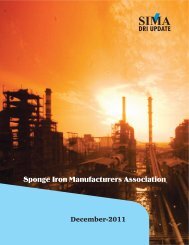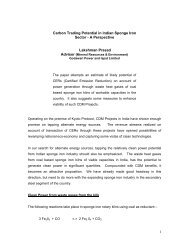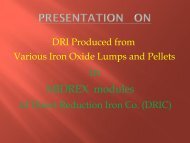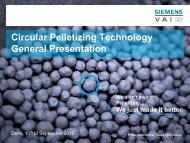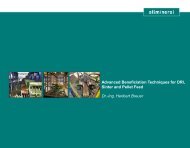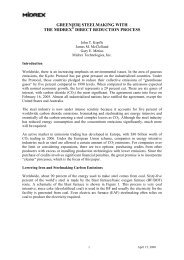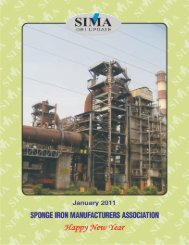You also want an ePaper? Increase the reach of your titles
YUMPU automatically turns print PDFs into web optimized ePapers that Google loves.
• Dust is generated during handling and<br />
transportation of iron ores, DRI, solid<br />
reducing agents and ash; the latter two<br />
only using alternate sources of reducing<br />
gases, other than natural gas. Typically,<br />
the material handling of an Energiron plant<br />
consists of the iron ore and product<br />
handling systems. These systems include<br />
bins, screening units, coating unit,<br />
conveyors, and transfer stations. Air<br />
pollution caused by dust is minimized by<br />
installing appropriate dust collectors in the<br />
main generation points, typically in trasfer<br />
locations and screening units.<br />
• Flue gases containing the polluting<br />
elements SO x and NO x , are derived from<br />
the combustion systems of the reducing<br />
gas generation units, gas heaters and<br />
rotary kilns. The amount of SO x and NO x<br />
can be decreased in gas based processes<br />
by an adequate control of combustion<br />
operations, and by desulfurization of the<br />
fuel gas stream to be used, both as<br />
process gas (reducing gas) and as fuel.<br />
The process chemistry of each technology<br />
will determine how difficult or how easy this<br />
control will be. In the case of the<br />
Energiron technology, SO x is selectively<br />
eliminated in the CO 2 absorption unit and<br />
NO x is easily controlled by low-NO x type<br />
burners, allowing compliance with even the<br />
strictest standards.<br />
• Suspended solids in the effluents from the<br />
water systems consist mainly of iron oxide<br />
and DRI particles, collected in the wet<br />
systems of the different sections of the<br />
plant. These solids can be dried and<br />
concentrated to be sold or reused as<br />
feedstock in the reduction units.<br />
Environmental Impact<br />
Emissions from Energiron plants are in<br />
accordance with the most stringent environmental<br />
regulations anywhere. This is achieved in large<br />
part due to the process design itself; while other<br />
processes require heat recovery equipment which<br />
tends to increase the NO x levels, the Energiron<br />
Process is efficient by design due to its process<br />
configuration and heat recovery systems.<br />
Depending on the type of plant, heat recovery<br />
systems consists of:<br />
• With external reformer - the efficiency is<br />
achieved by generation of steam, which is<br />
required for natural gas reforming and for<br />
CO 2 stripping. Prior to end-using, the steam<br />
is used in some steam turbines for power<br />
co-generation, reducing significantly<br />
electricity consumption.<br />
• With “in-situ” reforming, the steam required<br />
in CO 2 stripping is generated in the top gas<br />
heat recuperator.<br />
Thus, while achieving high overall thermal<br />
efficiency in the plant, there is no significant need<br />
for preheating the combustion air in the reformer<br />
or in the heater to high temperatures, thus<br />
eliminating the possibility of high NO x generation.<br />
For other DR processes, this is not the case and<br />
the choice between decreasing thermal efficiency<br />
or installing expensive de-NO x units remains.<br />
The tables summarize the environmental impact<br />
of Energiron plants, comprising solid wastes,<br />
emissions to the air and water, and noise. These<br />
levels comply with the strict standards imposed in<br />
such areas as the USA, Saudi Arabia, Malaysia<br />
and other nations with the most modern<br />
environmental standards, including new standards<br />
proposed but not yet enacted.<br />
Tenova HYL together with Danieli has been<br />
working on a project for a plant of 1.6 million tpy<br />
capacity being built for GHC in Abu Dhabi, where<br />
environmental controls are also among the<br />
strictest anywhere. Still, the values achieved are<br />
well within the requirements for compliance.<br />
Table I<br />
Solid Wastes (kg/ton DRI)<br />
Recycled Dumped Total<br />
• Dust collected 3.20 - 3.20<br />
• Iron oxide fines - 26.70 26.70<br />
• DRI cooling losses - 6.45 6.45<br />
• Others 0.25 0.35 0.60<br />
MAY-<strong>2007</strong>/34



